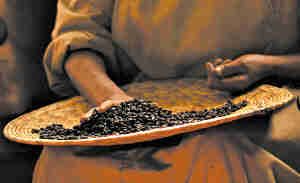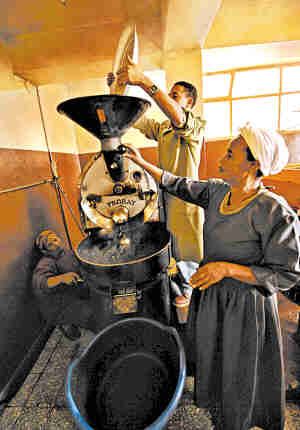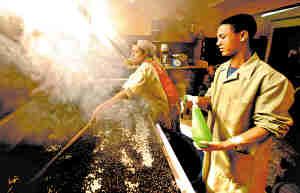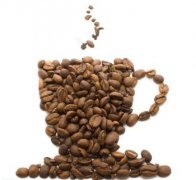Coffee is made in this way, the production process of coffee beans.

The women picked out the coffee beans that were not fully roasted.

The worker poured the coffee beans into the roaster

Pour the roasted coffee beans into the plate to cool down.
There is a place in Ethiopia called Kafa. Local residents have found that cattle and sheep become excited and powerful after eating a plant that grows small red beans. Later, people began to pick and consciously grow it, using Kafa as food, drink and medicine, and the world slowly defied it as Coffee.
That string of coffee cherries filled every corner of Ethiopia and the air with the smell of coffee. In traditional Ethiopian families, there are 2 to 3 coffee times a day, and there are a variety of drinking etiquette or rituals, coffee traditional culture strongly supports the country's coffee cultivation.
The coffee produced here belongs to Arabian species, and there are many kinds of coffee: Haller, Mocha, Yega Xuefei, Simoda and so on, among which Haller is the leader of many varieties.
Interestingly, although Ethiopia is the birthplace of coffee, the coffee maker in Ethiopia is left by the Italians. At the end of the 19th century, the Italians occupied Ethiopia and left it with their coffee maker and spaghetti.
Ethiopia is the largest coffee producer and exporter in Africa and the sixth largest coffee producer in the world. Here, there are many coffee workshops, large and small. Adhering to the idea that high-quality coffee should be as pure as a thoroughbred, the coffee workshop follows the traditional production process, so the wonderful taste is still so mellow. From green coffee beans to mellow coffee, there are a series of processing links, such as washing, drying, baking, grinding and so on, of which baking is the most important. Interestingly, Ethiopians also put pictures of horses on the coffee package to show the purity of the coffee.
Important Notice :
前街咖啡 FrontStreet Coffee has moved to new addredd:
FrontStreet Coffee Address: 315,Donghua East Road,GuangZhou
Tel:020 38364473
- Prev

The technology of stir-fried coffee beans the basic knowledge of coffee beans
Use wind and vibration to remove ash / soil / pebbles / metal and other impurities from coffee beans. The cleaning process is generally carried out on special machinery, or manual screening can be used. Then let the coffee beans pass through sieves of different sizes and grade them according to size. If possible, a colorimeter can also be used to monitor immature coffee beans and pick out coffee beans that are too light or too dark. Select by ultraviolet light
- Next

I'll introduce you to sour coffee. Sour coffee is not good.
Most people mistakenly think that coffee is sour if it is not fresh, and sour coffee is not good. This is really a great smear and misunderstanding! In fact, coffee itself is an acidic beverage. Whether coffee is sour or not depends on the baking degree of beans. The longer the baking time is, the higher the caramelization degree is, and the more acidic substances are destroyed, the less sour it is, and the shorter the baking time is, the lower the caramelization degree is.
Related
- Detailed explanation of Jadeite planting Land in Panamanian Jadeite Manor introduction to the grading system of Jadeite competitive bidding, Red bid, Green bid and Rose Summer
- Story of Coffee planting in Brenka region of Costa Rica Stonehenge Manor anaerobic heavy honey treatment of flavor mouth
- What's on the barrel of Blue Mountain Coffee beans?
- Can American coffee also pull flowers? How to use hot American style to pull out a good-looking pattern?
- Can you make a cold extract with coffee beans? What is the right proportion for cold-extracted coffee formula?
- Indonesian PWN Gold Mandrine Coffee Origin Features Flavor How to Chong? Mandolin coffee is American.
- A brief introduction to the flavor characteristics of Brazilian yellow bourbon coffee beans
- What is the effect of different water quality on the flavor of cold-extracted coffee? What kind of water is best for brewing coffee?
- Why do you think of Rose Summer whenever you mention Panamanian coffee?
- Introduction to the characteristics of authentic blue mountain coffee bean producing areas? What is the CIB Coffee Authority in Jamaica?

